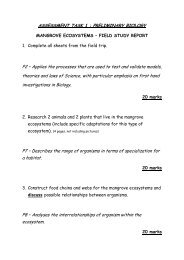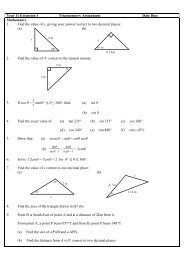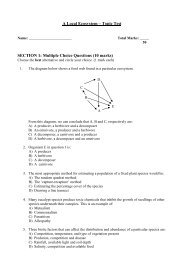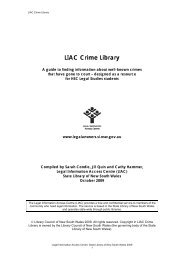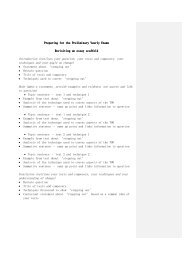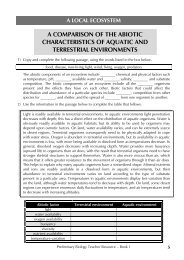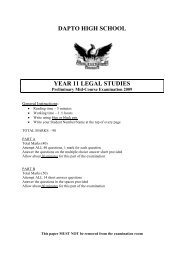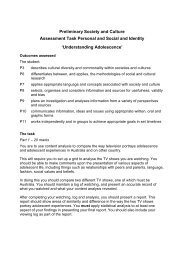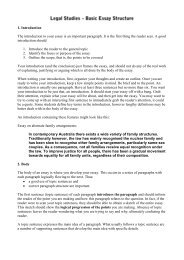Swimming Upstream Notes
Swimming Upstream Notes
Swimming Upstream Notes
Create successful ePaper yourself
Turn your PDF publications into a flip-book with our unique Google optimized e-Paper software.
Year 11 – Module C – Stepping OutText – Film – <strong>Swimming</strong> <strong>Upstream</strong> and related materialDirector – Russell MulcaheyDescription of Module In this elective students will explore texts that deal will aspects of growing up andtransitions into new phases of an individual’s life. Students will respond to and compose a range of texts that demonstrate the differentpathways into new experiences that extend their existing world. They examine the features of texts that show knowledge, attitudes and beliefs relating toindividuals who have ventured into new worlds and experiences.How <strong>Swimming</strong> <strong>Upstream</strong> links to the elective Stepping OutTony Fingleton is one of five children growing up in the difficult post way period of the 1950’sin Brisbane. Tony’s fondness for the piano and literature attracts negative attention from hisaggressive father. It is only when Tony succeeds in the swimming pool that his existing worldtakes a different pathway. His journey leads him to a more in depth understanding of himself andthe world he lives in.Historical Background to the Film – ContextThe film paints a bleak picture of Australian society in the 1950’s. This generation lived throughthe depression of the 1930’s and World War 2. It was an era of deprivation and unemploymentwas high. Many men like Harold Fingleton (father) were often frustrated by the lack of work andmoney. They carried a lot of anger. Harold worked at the Brisbane wharves as a wharf labourer.The work was tough, not always available and there were often industrial unrest due to strikesagainst lowly wages and long hours. An aggressive blokey pub culture existed amongst manyworking males. Harold’s constant unemployment problems and his inability to relatemeaningfully to his family paints a broader picture of Australian society at the time.What is the Film AboutThe film can be examined from several different levels It is the story about a young man who loves to swim and strives to be an Australianchampion and go to the Olympics. The film follows Tony’s journey from childhood toyoung adult. His journey is focused in gaining his father’s attention and love. By the endof the film he realised his is never going to be recognised by his father so his energy goesinto doing things for himself such as university and the Empire Games. On another level the story is about a father who has never quite made it and then uses hissons to try and accomplish something that he never achieved. It is also a story about a family dominated by an alcoholic father – he sets ip acompetitive environment for his two sons who compete both in the pool and out for theirfather’s attention. The film can also be seen as an exploration of Australian masculinity.
Characters in the FilmHarold Fingleton (father)Harold is an arrogant, short tempered alcoholic who demands to be treated like the man of thehouse, he works in a lower class job on the Brisbane wharves to support his family, expectsdinner to be served on time and always has a beer in his hand. He teaches his sons to becompetitive and to stand up for themselves with violence. He deals with his frustrations thoughaggression.Dora Fingleton (mother)Dora is frightened of her husband and is victimised by the drunk Harold. She ends up a prisonerin her own house unable to talk to friends and voice her own opinion. She feels she cannot leavehim as she will not have enough money or anywhere to live. She is a nurturing and caring motherand battles to find money to feed and clothe her five children. Her family comes before her ownwell being and stands up for her children when they are under the scrutiny of their father. Shedeals with everything except the constant alcohol abuse of her violent husband. She urges Tonyto be strong in the head to protect himself from his father’s belittling. She tells him he has thecapacity to make something of his lfe rather than relying on his father and her.Tony FingletonToney is a sensitive boy who wants to be loved by his father. He plays the piano and readsliterature – Shakespeare. Unlike his father who deals with his emotions through aggression andviolence he shows his emotions through talking and discussion. His father sees him as being too‘feminine’. Tony chooses not to drink like his father which shows a transition from thetraditional Australian male to a new age more sensitive male. Tony develops into the bestAustralian back stroker of the time. He struggles to get out of Springfield where he grew up. Heis near water whenever he needs to clear his head – the beach, the river of the swimming pool.John FingletonHarold gave John fake security and too much praise which in the end was his downfall. Hecompeted with Tony in the pool and also for their father’s attention. He and Tony often retreatedto the local pool to escape the emotional confliction in their family home.Harold JuniorHarold was favoured by their father. He was the macho bullying son. His father saw him asepitomising what a man should be like. He torments Tony and in one scene he slams the pianolid on Tony’s hands while he is playing the piano.
Film TechniquesPoint of ViewThe story is told from Tony’s point of view. Harold’s aggression towards him is often viewedfrom his mother’s eyes.Water Theme – water is symbolic of escape and is a major theme in the film <strong>Swimming</strong> PoolWhen Tony is young it represents him having fun with siblings. As he grows older itrepresents the badly needed escape of the harsh reality of a life dominated by the moodsof his abusive father. Success in the swimming pool is also the means to win his father’sattention and the means to get out of Springfield. Visual effect – water theme inside house – hallway sequenceThe narrow hallway inside the family house signified trauma and confusion for Tony. Heis seen floating through the hallway of his family home in one scene to escape theemotional distress caused by his father’s rejection. The hallway sequence sees Tony floatoff the ground and the walls ripple as if underwater then transform into the liberating bluespace of the swimming pool Fantasy swimming sequences usually follow conflict – eg When Harold stated he wasashamed of Toney of when he is unable to acknowledge his swimming success.Conflict within the family The gloomy interior of the timber framed Queensland family home provide aclaustrophobic space in which to stage the frequent family confrontations. Camera Shots – framingDora and Tony are consistently framed in the constraints of doorways and windows tosuggest their oppressive situations. These shots suggest that they wish to exit the homebut are trapped there. The ugliness of a violent altercation is viewed through a split puddle of xxxx beer on thefloor. Disturbing scenes of family conflict – eg the bloody fight between Harold and his twosons. This scene is shot up close and uncomfortably personal through the use of a handheld camera and a beneath the floor camera angle.Contrast between family drama and swimming scenes/ sound effects There is a marked contrast between the harsh realism of family drama and Tony’s dreamlike imaginings and the excitement and tension of the swimming races. The naturalisticstyle of the pool scenes are in contrast to the scenes inside the house which signifytrauma, confusion or escapism. <strong>Swimming</strong> sequences are sharp, vibrant and stylized – these scenes also represent thefantasy world into which Tony escapes – particularly the safety of his underwatersanctuary, The race sequences become a focal point which separates the doomed fate of Harold andTone’s escalating spirit. The race sequences are also the point where their two worldscollide. They can be seen to represent the world above the water and the world below.When Tony is in the water the naturalistic sounds of the day to day life are replaced withsurrealistic sounds beneath the water’s surface, as soon as there is a race or emotionalseen these surrealistic sounds are women into the atmosphere. The harsh nature of Tony’s daily life contains densely detailed sounds of theneighbourhood beyond the house. Sounds of domestic turmoil are head – yelling,
fighting, bottles breaking. Dogs barking and sounds of children give a sense of largercontextOther techniques Split screen format – combining both swimmers and spectators underwater and abovewater perspectives sustains the emotional suspense of the competitions. The split screentechnique allows two stories to be told at once. Techno inspired soundtrack enhanced the kinetic quality of the racing sequences. Live action footage from a mixture of Australian Olympic sized pools and the addition ofbackground details such as lights, boats and trains enhanced the life and movement ofswimming sequences.
<strong>Swimming</strong> <strong>Upstream</strong>ByRussell Mulcahy 2003Module C Stepping OutOutcomesStudents will explore and understand contexts such as: social, political, cultural andhistorical both in society and the textStudents will respond to texts in a variety of text forms – with a strong focus on nonliterarytextsStudents will understand and personally respond to issues raised in this module andmake links to the texts presentedStudents will develop strategies and confidence in identifying, selecting anddeconstructing appropriate related material
<strong>Swimming</strong> <strong>Upstream</strong>“By the ‘50’s the local pool was fast being regarded as an essential communityvenue for accessible and safe sport, education and leisure...”The Australian Aug 2-3 2008This is a film about a boy who, in his enjoyment of piano, books, and success at school, mustfind a way to gain his father’s attention and respect, and to achieve his dream “to besomebody...” – through swimming. 1 While he has success, his father’s insatiable, passionateneed to have his dream through others’ achievements drives Tony Fingleton from his belovedbrother John, his childhood mate and confident, and eventually leads him leaving his family andcountry.The film is set in the 1950’s – Menzies was Prime Minister, Australia was recovering from thewar, with a time of relative peace and stability (apart from the Korean War) but there was anincreasing fear coming from the nuclear threat and the Cold War between America and Russia.It was a patriarchal society, where women stayed at home and supported their husbands nomatter what, and women such as the independent Billie were the minority. The adultpopulation was investing its hopes for peace and prosperity with the post-war generation.But with progress there came problems – on the wharves, for instance, increasingmechanisation meant fewer jobs, and so we have the background for the beginning of RussellMulcahy’s <strong>Swimming</strong> <strong>Upstream</strong>.In our study we will examine some experienced that bring about change in a person’s life. Notethat while others in the film must inevitably change as a result of the father’s dominance, ourfocus is on Tony Fingleton.We will examine closely certain techniques used by Mulcahy to convey ideas.The establishing scenes with the use of music, camera angles, shots and contrastInterior home shots, mise-en-scene – handheld camera, lighting and framingJuxtapositioning of scenes showing the two worldsSymbolismUse of music_____________________1 This film is based on Tony Fingleton’s autobiography written with his sister Diane.
Establishing scene: the opening movements of a film – establish location, mood, central ideasor motifs. Often long shots or overhead to give a general idea.The film opens with a high overhead shot of a single swimmer, and moves through to a scene ina public pool with the sounds of children encouraging their brother in his underwater swim.Note the choice of music – extra-diegetic music, synthesised, harmonious, new-age kind ofmusic in which gives a peaceful, calm effect – the idea is that water, for our protagonist, hasspiritual associations beyond just being fun and freedom. His music becomes a motif 2 thatrecurs through the film. Mulcahy says in an interview that is was his intention to create twoworlds; the pool, with childhood associations of fun, freedom, fellowship 3 , and later, adrenalineand excitement – but overall the spirituality of it. 4 the choice of electronic music promotes thatidea. The second world is that of home, a world associated with fear and violence andoccasional peaceful and living moments.What is the effect of the lone swimmer shot? – we realise, by the end of the film, that this boyon his own, as a result of his father’s brutal influence he is alienated from his beloveredbrother, and he has had to become strong enough within himself to withstand his father’sassaults and the competition (recall his comment to one of his fellow swimmers “You’ll have todo better than that. I’ve been psyched up by experts.”What do we learn about the pool and the children from this early scene? This pool, we cometo learn, is a place of fun and freedom, connection with your siblings, a place where you cantest yourself safely without fear; it is, we soon see, a refuge from life’s darker moments.A voice over tells us that “water changed that ... kept you alive and safe ...”The happy pool scene is rudely interrupted by Harold Jr’s insistence they go to meet dad andmoves through to the children going onto the wharves, which we are told by our voice-over(adult Tony) were part of their world, “the pool, wharves, mother and father...”Note that number of labourers manually loading, unloading etc.A long-range shot shows such a figure riding a sling – the children looking up to it, “dad...dad...”We cut to Dora in an exterior shot, hot day, the drudgery of hand washing for a family of 7 –using an old-fashioned copper – contrast with Billie who is cool and elegant, well groomed andan invitation for tea – we see from Harold Sr’s reaction that she is not welcome._____________________2 Motif – an image, music, sound, object that has significance and is repeated through a text.3 Note that despite their experience of abuse at home the bonds between the children, except John, stay strong, aswe see Ron and Diane cheering Tony on at the Empire Games on TV.4 Water becomes a support for Tony – consider the scene when Tony “floats” through the house escaping hisfather’s terrible abuse.
The relative clam of the day is shattered with loud noises – Diane runs to the boys’ room andthey retreat to the pool.Pool shot – enclosed, clam, peace, silence (?) they excitedly race to be first in. – leaping tofreedom, fun and safety – music with xylophone, electronic supports the mood – congruousmusic (meaning it reflects and supports the scene rather than making comment on it).Interior shots of home – mese-en-scene 5Scenes at home – show a family with violence. In order to give a sense of something hedescribed as being “visceral” (primitive, to do with the gut) Mulcahy used handheld camera attimes which conveys a feeling of unease. From the first shots we see this as well-worn home,with marked paintwork, a labyrinth of rooms, many doorways that various family membersescape through. The rooms are cluttered with the stuff a family of 7 needs. Lighting is muted,(compare the light within the house to clear brilliance of the pool). There is an overallclaustrophobic feeling to the interior scenes. Characters are shot against frames – door ways,windows, suggesting being at the edge of things while still being part of the violence, somethingthat is reflected in the close-ups of their faces. In the kitchen where the worst scenes areplayed out, characters are forced into close proximity there is no escaping the violence in thishouse, even though we often see the younger children being sent off, or pushed out. Ratherthan this home being a place of refuge the mother and younger children run out of the house,away from the house.Proxemic range – The most damaging scene – in the kitchen, after the riot on the wharf –interior scene – lightning and storm outside, handheld camera, music builds, the walls appearto trap Tony – “you and your mother... I was tougher...” note the positioning of the characters –within the confines of the kitchen they are at the extreme edges – the proxemic rangeemphasises the distance between Harold Sr and his wide, and son.JuxtapositioningThe piano playing scene – peaceful, Tony playing for his mother, “I live the minute waltz.”Which quickly moves to a violent exterior scene of Harold Sr encourage Jr in his fight with Tony– piano playing is associated with poofs – piano players and sissies, “grow up to be a fairy” – thescene ends with Harold Sr declaring Jr to the “the champ!”This scene is followed by a pool scene – healing – away retreat, and connection with his brotherWater as a motifThe previously mentioned symbolism of water as a place of safety, fun etc – but for Tony it ismore – something special – he undergoes a cleansing ritual in the pool after the bloodybackyard fight._____________________5 All the visual elements within a frame – setting, props, lighting, costumes, acting style, positioning of actors
In the aftermath of the abuse kitchen scene, “When I was your age I was tougher...” the oldextra-diegetic note picks up to a pulsing heartbeat. This moves to a dislocated scene of Tonyfloating through the house to a dramatic accompaniment with chorus – to the pool itself,where we gather he was retreated for further cleansing.Note that after a scene of violence we will have a scene in the pool – emphasising the twoworlds. The pool is a sanctuary from the atmosphere at home, except when Harold Sr is present– note that comment a John makes, quite liking it when their father is drunk because they don’thave to work so hard....Ironically while the pool has been a sanctuary in their father’s absence, it is through swimmingthat Tony achievements a measure of grudging respect from his father.It is through swimming that Tony will escape.Note the beachside scene with his mother after John has swum against him, and won. Sitting onthe remains of a wreck, looking out to open sky, motif music plus layers of ambient sound. 6Tony wonders whether he could swim to America. Music is synthesised with building strings.Tony is looking out... beyond his oppressive, violent world which seems to be destroying him,his mother entreats him to be strong... in there. Tony breaks down, “wanted to be somebody...had this plan... then I could... I could just go...”This scene is repeated when Dora retreats there, looking out to the world that Tony will leavefor – motif music again.Closing SceneHarvard, newspaper headlines about Dawn Fraser’s wins at the Olympics, “Exactly where Iwantto be...” cut to joyous memory, water, John smiling, Diane grinning, music big, upbeat._____________________6 Ambient sound means the background sounds which are present in a scene or location. Common ambient soundsinclude wind, water, birds, crowds, office noises, traffic etc. Ambient sound is very important in video and filmwork. It performs a number of functions including: Providing audio continuity between shots. Preventing anunnatural silence when no other sound is present. Establishing or reinforcing the mood.
Misc notesFirst meeting Dora slaving away in the heat – her elegant friend Billie, who is not welcome – sherepresents female independence as opposed to Dora’s mainly submissive placatory behaviour.Note Harold Sr’s comment that he sang when Irish eyes are smiling the first time they went out– he was drunk.Note little Diane mimicking Dora ironing – the perpetuation of gender specific roles.After Harold Sr realises his sons are swimmers he demands they turn up at 5 – Tony has a pianolesson, but Harold Sr replies, “That’s enough poofter stuff. We’re doing something serious”Regular homophobic comments –At the pool diving for coins Harold Jr calls Tony a poofter ...Later, Harold Sr sneers at Tony, “fancy yourself as Esther Williams” – junior swimmingchampion, synchronized swimming, film star of the 1940s and 50s.Notice Harold Sr says “We’ve done it” and takes the trophy after John wins at the QueenslandState Championships.Scene of Tony and John quietly together – tight framing – beside the pool – Harold Sr intrudesand throws Hamlet into the pool – his disregard for Tony’s academic success and interest isreinforced.The ugly wharf scene with the boss – handheld camera, extra-diegetic music adds to the dramaand violence. The music acts as a transition to Harold Sr coming home very drunk andpoisonous. It is not clear. But is implied, that Harold Sr suffered at the hands of this man – “mymother, she was there... and they were animals...” Perhaps Harold’s homophobia is more thana simple cultural thing, but results from violent abuse by men his mother brought home. In thefollowing backyard scene with Dora and Tony Dora tells Tony that “he had to do some prettyawful things to survive... hates himself for it.”The scene in the pub – Dora intruding in a man’s world – note the camera angles diminishingher and adding the stature of the fellow who challenges her. “this is a men’s only bar, missues”and another says, “cant a man have a bit of fun...”




